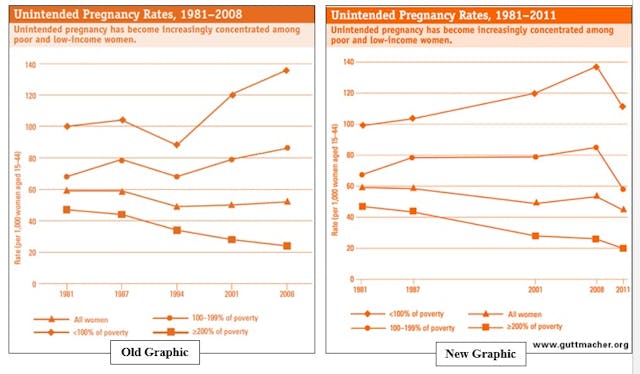It appears @WillKrumholz never read the @NEJM study where these data were published, it’s all explained there nejm.org/doi/full/10.10…

Guttmacher doctored data to boost Planned Parenthood’s contraception push (UPDATED)
Guttmacher doctored data to boost Planned Parenthood’s contraception push (UPDATED)
From Planned Parenthood being exposed for multiple horrific felonies and its president subsequently lying to Congress, from partisan witch-hunts against pro-life whistleblowers to the abortion industry refusing to crack down on medical malpractice in its ranks, from scores of politically-motivated studies debunked to Planned Parenthood officials stonewalling state investigations into their misconduct, the past year has not been good for the abortion lobby’s ethical image.
And now, Willis Krumholz at the Federalist has uncovered a particularly blatant example of one of its most respected partners manipulating data to benefit Planned Parenthood’s narrative.
This is only the latest in a series of articles Krumholz has written about what he’s learned from digging deep into the statistics behind Planned Parenthood’s activities and related societal data, and it may be the most damning. He noticed that after repeatedly seeing the below graph on unintended pregnancy rates in material put out by the pro-abortion research organization Guttmacher Institute, suddenly their latest report replaced it with the graph to its right:

The old graph showed that low-income, unintended pregnancy rates were decreasing before 1994—before which Planned Parenthood had more competition from other women’s health providers and intrauterine devices weren’t as widely used—but shot back up after. But the new one removes the 1994 data point entirely, giving the impression of what Guttmacher calls “rising for most of the 30-year period beginning in 1981.”
After providing interesting background on how Planned Parenthood was able to capitalize on increasing regulations driving smaller and less established competitors out of the market (enabling PP to raise abortion prices and giving them less incentive to provide high-quality non-abortion care and provide less contraception), Krumholz notes that this deception has helped Planned Parenthood spread across the media its self-congratulatory fantasy that IUDs finally stopped unintended pregnancy rates from spiking when all else had failed:
The truth is that unintended pregnancy rates were falling until the mid-’90s and then they suddenly shot up. Why did they shoot up? If IUDs are so great, why was the unintended pregnancy rate lower in the early ’90s, before IUDs were as widely used? If Planned Parenthood is so great, why was the unintended pregnancy rate lower in the early ’90s, before Planned Parenthood tripled its market share?
And, surprise, Guttmacher is uninterested in discussing it’s sleight-of-hand:
Starting on March 30, I called Guttmacher’s listed media contact on this press release to ask for a comment. I’ve called more than ten times since then, and left several messages, including on the media contact’s cell phone, and I’ve received no response.
This statistical deceit is to be expected from Guttmacher, which began as a research arm of Planned Parenthood, still openly favors abortion and contraception as a supposedly-independent entity, and which Planned Parenthood has repeatedly called an affiliate of theirs over the three decades after they publicly separated. Regardless of what their official relationship is today, it’s clear that Guttmacher remains committed to the cause of its former parent organization—and is willing to twist the truth on their behalf.
The more important lesson to draw from this, though, is that the supposed contraception-as-silver-bullet conventional wisdom is even shakier than you thought.
We already knew that such claims were faulty for a number of factors, including ignoring evidence of reduced or delayed sexual activity, lower use of IUDs than assumed, contraception already being cheap and accessible without government intervention, the pro-life laws resulting in more mothers choosing life, and overseas examples being undermined by a litany of cultural variables that either provide alternate explanations for the data or make them non-analogous to the United States. (Pro-choice readers still stumped by this should read up on the law of diminishing marginal returns and reflect on how much of a difference even more contraception can make in a society already saturated with it.)
But this seems to suggest that the evidence in contraception’s favor may be even weaker than we skeptics have been assuming. How many other data sets has Guttmacher selectively altered over the years to cover up not only the limitations of Planned Parenthood’s product, but to obscure Planned Parenthood’s role in causing the very problems it claims to be the solution for?
Pro-lifers have long asked why an organization billing itself as pregnancy preventers would be believed while they so aggressively promote the activity that causes unintended pregnancies in the first place. And now we see how they get away with scamming taxpayers out of millions to pretend to clean up their own mess: because they know that no matter what they do, their “former” propagandists at the Guttmacher Institute are on standby to cover their tracks.
UPDATE: Guttmacher spokesman Joerg Dreweke has responded to Krumholz’s original piece, claiming the 1994 data was removed because it was found to be methodologically flawed and therefore artificially higher than it should have been:
Krumholz has responded, promising that a rebuttal is in the works:
This tweet is no longer available. It may have been deleted or made private. Try on X.
Live Action News has covered his response here.
Live Action News is pro-life news and commentary from a pro-life perspective.
Contact editor@liveaction.org for questions, corrections, or if you are seeking permission to reprint any Live Action News content.
Guest Articles: To submit a guest article to Live Action News, email editor@liveaction.org with an attached Word document of 800-1000 words. Please also attach any photos relevant to your submission if applicable. If your submission is accepted for publication, you will be notified within three weeks. Guest articles are not compensated (see our Open License Agreement). Thank you for your interest in Live Action News!
Read Next

New Archbishop of Canterbury warns of danger in legalizing assisted suicide
Nancy Flanders
·More In Analysis

Analysis
Florida Supreme Court rules sperm donor can seek parental rights
Cassy Cooke
·
Analysis
Fact Check: Woman says she was denied treatment as baby 'poisoned her from inside out'
Nancy Flanders
·
Newsbreak
Pro-life leaders encourage pastors to preach against abortion
Angeline Tan
·
Human Interest
Canadian actress seeks euthanasia for mental illness. Her doctors are divided
Nancy Flanders
·
Issues
Study claims women who have an early career abortion make more money
Nancy Flanders
·More From Calvin Freiburger

Politics
Connecticut Gov. intends to give $10.4 million to Planned Parenthood
Calvin Freiburger
·
Guest Column
Report finds false advertising among Pennsylvania Planned Parenthood centers
Calvin Freiburger
·
Abortion Pill Reversal
Tennessee prosecutor refuses to enforce law to inform women of abortion pill reversal
Calvin Freiburger
·
Guest Column
Stillbirths on the rise amid COVID-19 lockdowns around the world
Calvin Freiburger
·
Abortion Pill Reversal
Abortion groups sue over Tennessee law requiring abortion pill patients to receive information on reversal
Calvin Freiburger
·